Jeff Goins's Blog, page 43
March 7, 2016
9 Audience-building Tips You Can Count On
These days, it’s hard to get noticed. The Internet is a noisy place, and the world isn’t getting any smaller. But there’s a lot of bad advice out there about how to go about this the right way.

In the past five years, I’ve built an audience of literally millions of fans of my blog, books, and podcast. I’m certainly no expert, but I’ve learned a few things from the past several years of doing this and coaching and teaching thousands of others in doing the same.
Here’s my best advice on how to build, maintain, and grow an audience:
Start with one. Serve one person, reach one fan, get one reader. And cherish them. Don’t despise small beginnings. They’re the only kind most of us will have.
Under promise, over deliver. Go above and beyond. Wow people.
Don’t forget to build your craft. Lots of people want attention these days for skills that aren’t really worth noticing. The countercultural thing to do is to take your time and make sure you get good before you get noticed.
Keep your sense of humor. Sometimes, people take this idea of reaching a tribe a little too seriously, or a little too personally. Have fun with your work. Be open to feedback. Thank people often, and let yourself play once in a while.
Enjoy the journey. I had a student recently message me with an exuberant update: “I just reached 50 email subscribers!” He was elated, but then got embarrassed, because he admitted that wasn’t “many” people. I chided him, saying, “No, this is exactly the way to do it. Count every reader as a blessing.”
What you win them on, you will raise them on. If you give away a bunch of free stuff at the beginning, people will expect you to continue that generosity. If you send a certain number of emails per week to your subscribers, you’ll need to keep doing that.
Not all audiences are created equal. Be careful what kind of audience you build, because you will have a responsibility to maintain that audience. So don’t just see people as a means to an end. The relationship is the end.
Permission rules. You cannot, and should not, get away with doing anything the audience has not give you permission to do. When in doubt, ask. And when they say no, listen.
Small and relevant is better than big and noisy. The truth is you do not need as many fans as you think you do. You need a small tribe of dedicated listeners, viewers, or readers who will rave about everything you do. That is more than enough.
If you feel like you don’t yet have an audience, allow me to bust that myth: someone is always watching. Someone is always listening. Don’t take that for granted. Serve the people who are paying attention to you now, and you will have the opportunity to reach more people.
Want to learn more about building an audience? Join me for a free webinar later today.
What have you learned, good or bad, about building an audience? Share in the comments.

March 4, 2016
Working Creatives, I Want to Hear Your Story
I’m writing a new book! I’m in the research phase right now, gathering stories from the working creatives from all walks of life, and I want to hear yours.
If you’re a working creative (or are introducing me to someone who is), please fill out the interview below, using as much detail as you’d like. Stories are welcome, and I may follow up with you if I have more questions.
Thanks,
Jeff
Loading…

March 2, 2016
096: Navigating the Intersection of Faith and Writing [Podcast]
Your personal beliefs are part of your identity. What you believe inevitably ends up in your art. But how do you stay true to your values without alienating your audience? It can be kind of tricky.
No one likes being preached at or judged. I certainly don’t. I’d much rather prefer a friendly chat over coffee to listening to someone scream at me through a megaphone.
Some of you who follow my work probably know that I’m a Christian. It’s not something I’m ashamed of, but at the same time, it isn’t the topic of this blog. For some, that has been confusing. So I dedicated an entire podcast episode to answering that question.
This week on The Portfolio Life, Andy and I talk about how faith informs what I create and why this is an ongoing conversation for me. Listen in as we discuss the value of a diverse community and rejecting the idea of using the “right” words.
Listen to the podcast
To listen to the show, click the player below (If you are reading this via email or RSS, please click here).
Profess truth without preaching
Most people I meet want to believe in something “more,” to believe they have a purpose, a calling, a destiny. We want to know why we are here and what our lives are about. A friend of mine years go said: “Everybody is looking for hope.”
Talking about this kind of thing with people from all walks of life are the kinds of conversations I enjoy the most — online and offline. I like talking with different people who hold diverse beliefs and ideas. Open conversations are where community is birthed, friendships are forged, and lives are changed. Those are the types of conversations I want to have.
Before Goins, Writer, I used to write on a personal blog about matters of faith and leadership. Truthfully, I felt limited by it because it closed off conversations. If people believed what I believed, they would tune in. But if they didn’t believe what I believed, they would tune out.
That is one of the reasons I’m so grateful for the diverse community of The Portfolio Life, GoinsWriter.com, and Tribe Writers. While faith inspires my creative work, it’s not the main theme. I don’t believe that’s the point of faith. It should fuel the work you do in the world, not be an end in itself.
Whatever belief system you have, even if it’s a belief in nothing, that’s still a belief. And I think it’s more powerful to give someone the opportunity to interact with that belief than it is to simply talk about the thing. It’s my opinion that we should meet as many people as possible and not seclude ourselves from those who think differently from us.
Show highlights
In this episode, we discuss:
Whether you should or shouldn’t talk about faith on your blog
How faith inspires art without being the subject of it
One thing everybody is looking for
Why two world-changing writers were at odds over faith yet remained the closest of friends
The difference between being ashamed of your beliefs and being intentional with your message
What Apple and Jesus have in common
Quotes and takeaways
If people want you to talk about something in a certain way, they’re never going to be happy until you talk about it their way.
Relationships take time to grow. Whether it’s face-to-face with a new friend or through a screen or book with a reader.
Belief is enough to stand on it’s own. You don’t need to sell it.
Through diversity we learn things about ourselves and each other, and become better versions of ourselves.
Resources
Living Forward by Michael Hyatt
The Lion, the Witch, and the Wardrobe by C.S. Lewis
The Hobbit by J.R.R. Tolkien
The Most Trying Part of Living a Good Story
How does your faith inform your writing? How do you approach the topic in your art? Share in the comments

February 29, 2016
5 “Secrets” to Living the Good Life
Recently, I did a reboot on my approach to life and work, wondering if how I’ve been doing things is the right way. The truth is I’m still not sure. But the experience has taught me some important lessons I nearly forgot.
Before sharing these lessons, here’s a quick side note: many “successful” people don’t consider themselves a success. This is a word other people give to your achievements. So while I don’t consider what I’ve done successful, I appreciate that this is what some people perceive.
The truth is, I have achieved far more than I ever thought possible after starting this blog five years ago. So this is a cautionary tale. Be careful what you wish for, as the saying goes, because you just might get it. So you’d better be sure you’re wishing on the right star.
If you want to live a good life, if you want to do good work and make a difference in the world, then you have to go deep. You have to explore uncomfortable questions like, “Why am I doing this?” and, “Just because I can do this, should I?”
Awhile back, my friend Jonathan Fields (who, by the way, has tackled the question of what it takes to live a good life better than anyone else I know) and we talked about these very questions on his podcast. In that interview, he said,
You’ve built something. And you’re comfortable. And you’ve got a certain structure around it. You don’t want to complain to anyone else. But there’s something inside you saying, ‘something’s not right.’
Yes, that’s exactly right. So what does it take to live the good life? What did I remember after getting everything I wanted and realizing something wasn’t right? Well, there were five things, which we’ll call “secrets”, though they’re kind of obvious when you think about them.
Secret #1: It’s not (just) about you
You were lied to, when you were told that if you worked enough hours, got enough stuff, and followed enough rules, that you’d be okay. That you’d be happy. But now, hopefully, you know the truth: We only find fulfillment when we let go of comfort, when we risk losing everything. That’s what a really good story, and incidentally what a really good life, is all about.
Secret 2: Passion is not optional
It’s not enough to simply commit to a task and do it really well for the rest of your life. You were put on this earth to do something, something specific. Until you do, you will be anxious and on-edge. Passion is what we need to have a fulfilled, whole life. Of course, passion alone won’t necessarily get you everything you want, but without it, you will die a slow, bitter death.
Secret 3: Just because it’s hard doesn’t mean you shouldn’t do it
Anything worth doing is difficult. It will require courage and strength from you; otherwise, it’s probably not worth doing.
Nobody goes to the gym to feel good. They go there to sweat and scream and stretch themselves. And they leave better versions of the people that entered an hour before. If you’re going to grow, life will at times be hard. Get used to it.
Secret 4: Fear is your friend
FDR was wrong. We shouldn’t fear fear. We should embrace fear as a part of life. Fear is the flinch, telling us that we could die. It reminds us of what’s dangerous and why we’re prone to avoid pain.
Fear is good. It keeps us alive, but it also keeps us compliant (if we’re not careful). My rule of thumb is this: if I don’t feel afraid of doing something, then I’m probably playing it too safe.
Secret 5: Values are better than goals
If you don’t know where you stand on work and friends family when an opportunity to succeed at something comes along, you’ll screw it up.
The best way to get your life in order? Screw the goals and skip the plans. Jump straight to values, your non-negotiables for how you do business, treat your loved ones, and do life. Everything else falls under this.
Sure, plans are good and goals are fine. But even Hitler had goals. The Nazis had a very well-designed plan. That’s not enough to live a good life. You have to have values, good ones, in order for your life to make a positive dent in this universe.
Here’s hoping you do (and God willing, me too).
Everyone has his own specific vocation or mission in life; everyone must carry out a concrete assignment that demands fulfillment. Therein he cannot be replaced, nor can his life be repeated, thus, everyone’s task is unique as his specific opportunity to implement it.
—Viktor Frankl
Bonus: If you want to learn more about living the good life, tune in with me later this week for a live chat on Blab with my friend Michael Hyatt about how to stop drifting through life and finally get to do the stuff you dream of doing.
How do you define “success”? What is one of your secrets to living a good life? Share in the comments.

February 26, 2016
3 Keys to Schedule Your Dream Job
Finding meaningful work can be challenging. It usually involves a mix passion, proficiency, and profitability. If you’re not emotionally engaged, competent, or getting paid enough to cover your bills, you’ll wrestle with burnout, frustration, and worse.
But let’s say you know exactly what your dream job is. You’ve got your sights set on something right up your alley and smack-dab in the center of your sweet spot.
Now what?
We’ve all been around people who seem like they have their dream job, but can’t quite make it happen. Maybe that’s you. You know what you were called to do, but you just can’t seem to get the traction you want. Or, maybe you’re flying high but feeling down because your life is totally out of balance.
I’ve got one piece of advice, and it works for both conditions. Following this strategy has enabled me to stay productive with work I love for decades, whether in the corporate world or as an entrepreneur. Here it is:
Schedule your dream job.
I discuss exactly how in my new book Living Forward: How to Stop Drifting and Get the Life You Want. It comes out next week, but here’s a sneak peek at three tactics to make time for what matters so you can gain the momentum you desire and sustain it for the long haul.
1. Schedule your priorities
And I mean all of them. Sometimes we know exactly what we want to accomplish work wise. We charge forward full of energy and enthusiasm. But in our extreme focus, we can easily neglect everything else.
I love Gary Vaynerchuk, and I love his book Crush It. I’ve recommended it countless times. But sometimes we stay in perpetual crush-it mode and miss other areas of our life that give us meaning, don’t we?
Put your work aside for a moment. What about your significant relationships, your health, your spiritual life, even your hobbies? Here’s the reality: What doesn’t rank doesn’t fit. If you don’t schedule time for all the things that matter in your life, your dream job will become a nightmare.
2. Schedule your week
When you’re scheduling your priorities, it’s best to start with your ideal week. What does it look like? Are you preserving the kind of margin you need for everything that matters?
Why your ideal week? Because it puts you in the driver seat. It’s a way to proactively prioritize. Your taking a stand for what matters most to you. Without doing the advance work of scheduling an ideal week, it’s too easy to slip into a reactive mode and get sucked into other people’s agendas.
The trick is to take everything you want to accomplish across all the areas of your life and get them down. It becomes your template for meaningful action. And the more precise you are, the more productive you’ll be.
When we’re vague on our time, our work feels vague too. Tasks expand to fill available time, and we find ourselves making far less progress than we want or are capable of.
3. Schedule your year
This might seem like a stretch at first, but it’s critical for making significant progress. Once you know your priorities, you need to protect them. The best way to do that is to set aside the nonnegotiables: holidays, vacations, work travel, key meetings, and so on.
Then you want to block time for discretionary activities like conferences or other enriching events.
This is a great opportunity to get clarity about your targets. One of the ways we find happiness is to make significant progress towards meaningful goals. That goes for all of life, but it’s critical for our work.
Without big, compelling goals, work becomes humdrum. And the best goals have deadlines and incremental steps you can schedule. Maybe it’s writing a book or launching a new business. Whatever it is, get the key dates on your calendar.
These three tactics should point us to an important fact: Meaningful work cannot be disconnected from a meaningful life. A dream job is one part of a dream life. And getting intentional about our time is the first way to make that dream a reality.
“Meaningful work cannot be disconnected from a meaningful life.Michael HyattTweet thisTweet
Michael’s new book Living Forward show how to integrate our daily work with our dreams. If you preorder it by February 29, you’ll get $360 worth of bonus materials and tools to help you design — and get — the life you want. Don’t miss it!
What is your dream job? How can you apply the principle of scheduling to your dream job? Share in the comments.

February 24, 2016
095: Why Time Management Doesn’t Work: Interview with Alli Worthington [Podcast]
Have you ever had to kill a project you were thrilled about? Letting go of something is hard but sometimes necessary when you’re over-committed to too many things.
One of my very first breakout speaking gigs was at Blissdom, a popular blogging conference accidentally founded by my friend Alli Worthington.
Yes, by accident. She winged it the first year and the rest is history. But after six roller-coaster years, while planning speakers and themes for next year’s event, Alli pulled the plug and BlissDom was finished practically overnight. The sudden death left her community surprised and disappointed.
Why quit such a successful endeavor in its prime? What was she thinking?
This week on The Portfolio Life, Alli and I talk about what prompted her seemingly rash decision to shut down her conference, and the 10-year journey she took to write a book on busyness. Listen in as we discuss the enemy of calling and why embracing the season you’re in is key to finding fulfillment in your work.
Listen to the podcast
To listen to the show, click the player below (If you are reading this via email or RSS, please click here).
Breaking bad habits
“Busy” has become the new “fine.” When friends ask how things are going we tend to say the word “busy” with our first breath.
This is something I struggle with.
On any given day, I may be running late to a meeting due to the call before that ran over the alotted time. Then I feel bad for being late and let the meeting go long, which makes me late getting home to help my wife. I walk through the door, frantically texting something to my team before it falls through the cracks.
Trying to keep track of everything is distracting, and some days I feel busy all day long. At home I’m thinking about all the work that needs to be done, and at the office I feel guilty for not being at home with my family.
One of the things I found most interesting about Alli’s story and her book, Breaking Busy, is the rejection of this idea of obligation. We all have things we have to do that we don’t want to. That’s part of being an adult. But there are far too many things we say “yes” to merely because don’t want to disappoint someone. We know we don’t have the time or energy to spare, but we say “yes” anyway and somehow try to make it work. All the while, our lives are getting more chaotic.
Breaking bad habits like unnecessary obligations helps us end the cycle of busyness and create margin in our life for what really matters. And as a writer, I’ve found that this is essential to any kind of creative success.
Show highlights
In this episode, Alli and I discuss:
How writing a book is like punching yourself in the face
The wrong reasons to write a book
Why it’s easy to act brave from behind a computer screen
Listening to the calling on your life even when people think you are crazy
How different aspects of your life work together to make up your portfolio
Dealing with skepticism and rejection from your tribe
A decision-making framework for minimizing busyness
How to do all the things without losing your mind
Living a full life without feeling frenetic
Quotes and takeaways
“Your calling looks different in each season of your life.” —Alli Worthington
“If time management was really the issue, we wouldn’t still have a problem.” —Alli Worthington
“Just say no to unnecessary crazy.” —Alli Worthington
Life is messy, but it doesn’t have to be hectic.
Stepping out into the unknown is intimidating.
Resources
Breaking Busy by Alli Worthington
Break Free From Busyness and Do the Work You Were Meant For
Propel Women: Celebrating every woman’s passion, purpose, and potential
Alli’s blog
What obligations do you need to say no to? How is busyness robbing you of your calling? Share in the comments

February 22, 2016
The Hard Part About Finding Your Calling
These days, there’s a lot of talk about dreaming. Now more than ever, finding your “dream job” seems to be a God-given right for anyone with a brain and an Internet connection. We feel entitled to purposeful work, but few actually find it.
Gen Y, the generation just entering the work force, is famous for its unwillingness to exchange their ideals for a paycheck. Passion is primary, but pursuing a dream for most people is extremely difficult. Why? Because they struggle with the hardest part of realizing a dream: knowing what it is.
I’m sure there are people out there who know exactly what they were born to do. They’ve had a vision for their life since they were six years old. I’m sure people like that exist—I’ve just not met any of them. Most people who have a dream struggle to articulate it; they don’t know what it is or what it should look like. If they do, it’s little more than a vague notion.
Do you know what your dream is? When people ask me that question, I stutter and trip over my words. Words like “sort of” and “kind of” abound. Insecurity rears its ugly head. And I feel like an absolute fake.
The other day, I was on a call with a young woman who was passionate about getting involved in social work—she just didn’t know where to start. As the discussion continued, she confessed that she didn’t know what her calling was. Was this her dream or just another idea? Due to her own inexperience, she was hesitant to name anything too specific.
Experience leads to confidence, and until you’ve done a few things, it’s easy to hold back from committing to any certain path. It might, after all, end in failure. A calling is an accumulation of a person’s life’s experiences, skills, and passions. It’s what you were put on this earth to do, so you should be a little cautious in naming it.
There are major implications to identifying a dream and chasing after it, so take your time in coming to the realization of what you were made to do. A little hesitation is natural. I’m wary of people who can name their dream immediately without having had any real experience with it.
Although you do encounter those rare cases of a person knowing what they were meant to do since the age of five, most people struggle with this. If you tell me, “I want to be an author” but have never written a word, I’m skeptical. If you say, “I was born to be a carpenter” but have never lifted a hammer, I’m dubious. You may like the idea of being a writer or the image of being on a construction project, but you haven’t done any actual work. You don’t understand the cost of your dream, of putting yourself out there, risking failure before you get your first “yes.”
The hardest part of realizing a dream, or finding a calling, is naming it. And it should be. This is your life’s work we’re talking about. But this line of thinking, of questioning yourself and wondering what your dream is, can paralyze you. You can get stuck doing nothing.
I know a lot of people who do this. Of course, they’re not really doing nothing. They’re working at Starbucks or in corporate America. They’re living in their parents’ basement or a loft in the city. It doesn’t really matter; the bottom line is they’re biding their time until “real life” starts. The problem is these people are procrastinating their dream and putting off their calling. They may say they’re waiting for the right time, but I don’t buy it. They’re wasting their life—at least part of it. You can always be doing something to further your calling.
So I propose an alternative, something in between doing nothing and picking the wrong dream: Make a seasonal commitment.
Guess at something that strikes your fancy, based on the possibility that it could be your dream. In other words, experiment. Not in a flaky, non-committal way. Pick something, and commit to it for a season. Call it a seasonal dream, if you want. This will give you experience, broaden your skill set, and teach you the value of commitment. Most likely, this is how you will find your dream. Not by waiting around, but by doing something.
There’s one thing you can be sure of: you won’t find your dream by standing still. Finding your life’s work will not be easy. You will have to work at it. It will require action and reflection, and that’s how awareness is grown.
Bonus: Curious if you’ve found your calling? Here are seven signs you’ve found it. Click here to download.
Are you waiting on your dream? What seasonal commitment can you make? Share in the comments.

February 17, 2016
094: The Wrong Reason to Go (Back) to College [Podcast]
Recent graduates are faced with disappointment in a college experience that implicitly promised them a marketable skill and good money. Unfortunately, the ROI of a traditional degree pales in comparison to the alternative.
For generations, a college diploma was a ticket to a better life. You finished high school, attended a university, got a decent job, started a family, and lived the dream.
If you wanted to level up your career again, all you had to do was go back to school for your masters. This typically bumped you up a few rungs on the ladder and accelerated your career.
Today, many graduates, burdened with student loans and disillusioned by their prospects in the job market, are returning to school under the false notion this will help them circumvent the real problem. A broken system.
This week on The Portfolio Life, Andy and I talk about alternative options to higher ed and how a customized educational experience can lead to greater success on a shorter timeline.
Listen in as we discuss the proven benefits of online courses and why it’s never too late (or early) to start learning differently.
Listen to the podcast
To listen to the show, click the player below (If you are reading this via email or RSS, please click here).
Skip the student loan debt
One night, my wife and I sat down to calculate the costs of sending our toddler to college some day. The results were staggering.
Given the rate of inflation, rising tuition, and estimated market trends, it will cost roughly $180,000 to send our son to a 4-year, in-state school when he’s 18 years old. And that’s just for one kid.
It’d be cheaper to pay the tycoons on Shark Tank to let our son shadow them for six months and learn first hand from their successes and failures of running multi-million dollar businesses.
While that sounds outlandish (or awesome depending on your feelings about Mr. Wonderful) the truth is not far off. Many experts and thought leaders in every field imaginable are willing to share their knowledge through online courses.
You can learn just about anything online. Either on YouTube, via a course library, or directly from a professional who has created a deep dive experience on a given topic.
One of the things I find most interesting and valuable about online courses is the practical application. In stark contrast to most college classes, in an online course you learn a principle and immediately can turn around and apply it.
Wherever you are, there’s an opportunity for you to find the skills you need to do the kind of work you want to do. Usually for far less money than the cost of a college degree.
Show highlights
In this episode, we discuss:
How online courses differ from online colleges
Why college is still a formative experience
The value of focused learning versus general education
Debunking the stigma of “making a buck” products
How an 18-year-old Tribe Writer skipped college and built business
Keeping the promise you made to yourself as a kid
The best thing you can do if you want to be the best at what you do
How do you do what you love and pay the bills
Alternatives to consider before you spend a dime on more education
Quotes and takeaways
Great work is it’s own reward
Find ways to share your gift with the world.
It’s an incredible feeling when you’re doing the work you were meant to do.
Reject the excuse of not having enough time, money, or resources.
Don’t go back to school just because you don’t know what else to do.
Resources
How to Find Your Calling with Jeff Goins on The Art of Charm.
Climbing the Ladder with Gary Vaynerchuk on The Art of Charm
Launch a Bestseller with Tim Grahl
How are you choosing to educate yourself? What’s the best way to educate future generations? Share in the comments

February 15, 2016
4 Keys to Succeeding in a Virtual Work Environment (We’re Hiring!)
These days, virtual work environments are becoming more commonplace. But how do you work in such an unconventional environment? It’s not as easy as you might think.
I’ve worked from home for over 10 years, the first seven of which were for somebody else and the past three have been for myself.
During that decade, I’ve learned a ton of lessons, many of which were acquired through the painful crucible of failure. Here’s what I’ve learned, and what you may want to consider if you’re searching for a virtual job (or wanting to run a virtual team):
Know yourself
I lost an employee because this person realized that working from home by yourself all day isn’t as fun and exciting as it sounds.
I’ve had to learn this lesson, as well. What do I need to thrive in my work? I need occasional interaction with people, but often I need to be left alone to work. This was why I eventually invested in an office outside of the home, to create a separation between work life and home life.
That doesn’t mean that I don’t sometimes work from home (I do), but having a dedicated space where I can leave things and/or escape to when I need to just get stuff done is really important. By no means does everyone needs an office like this, but I know I do. I also know that I need some social interaction, so I schedule a few lunches with friends every week.
Create a predictable rhythm
I first learned this working a day job for a nonprofit from home. My wife would leave every day at 8:30 in the morning and return around 5:30 every evening.
Early on in our marriage, I would sleep in, slowly get to work, and then disappoint her when it was dinner time and I still had work to do. Quickly, I learned there was nothing wrong with working a 9-to-5, especially if it meant getting share the evenings with my spouse.
Nowadays, I leave the house at the same time every day and return home around the same time. I have standing weekly meetings with friends and other groups that help me grow. Some days are dedicated to writing and other days are dedicated podcasting. I try to batch things and create blocks of time in which I always work on the same thing.
All of this creates a predictable rhythm that allows me to just show up and do the work.
When in doubt, over-communicate
If you don’t do anything else on this list, do this. I have had to fire people and almost been fired myself for violating this rule.
When working remotely, it’s so easy to misread tone in an email or text. It’s far too easy to hurt someone’s feelings or have your own feelings hurt when that was never the intention of the message.
Every relational conflict I’ve ever experienced in the workplace could have been avoided by better communication. And that’s not an exaggeration. The onus is on you to make sure the person on the other end of the line understands what you intended to say.
Clarify, clarify, clarify.
Don’t rely too heavily on technology
With all the amazing communication tools available to us (e.g. Skype, Facetime, Slack, Google Hangouts, email, etc.), working remotely has never been easier. But that’s not to say it’s not without its fair share of complications.
Technology cannot replace the connection two human beings forge with one another when working towards a common vision. In my experience, this means almost always trying to do the harder thing. When emailing is easier, pick up the phone. When calling is the most comfortable choice, get on a plane.
The point is, whenever you feel inclined to do something that avoids confrontation, do the hard thing. It’ll make your job much easier in the long run.
Recently, I opened up applications for seven new positions we have available at Goins, Enterprises (the fun little name of my business which includes this blog, the online courses that I teach, and the events we do).
In the past, I’ve worked with contractors and freelancers, but now I’m wanting to grow a more dedicated team.
If you’d like to be a part of that team, check out this link and fill out the form at the bottom of it.
What lessons would you add to this list? Share in the comments.

February 12, 2016
How I Used Medium to Get My First 20,000 Subscribers in 6 Months
I started blogging seriously in May of 2015. However, I didn’t want to solely publish at my own blog, since literally no one except my wife knew it existed. So every time I published an article on my blog, I copy and pasted it into Medium.com and published it there as well.
Medium is a popular and innovative platform based in Silicon Valley. The readers (and writers) at Medium are interested in entrepreneurship, self-improvement, cool ideas, good research, interesting stories, and lots more.
At Medium, content really is king. You may have a huge platform or be “well-connected,” but those things only get you so far at Medium. Only the best content consistently gets pushed to the top, regardless of your current following. This is an enormous advantage as what you write is completely in your control.
So, if you’re willing to write content “so good it cannot be ignored”—hopefully every writer’s goal—you can use Medium to launch your writing career and build your platform.
The remainder of this post will detail my story and strategies—how in six months:
I went from zero to 20,000 subscribers
Had articles published on outlets like Huffington Post, the Observer, and am now in works with TIME.
Had influencers endorse my work
My Story: From May 2015 to January of 2016
Last May, I really started researching the publishing industry. I had written an eBook and was anxious to know how to traditionally publish it.
I decided literary agents would be my best resource. After all, they know the publishing industry back-and-forth. After talking to 5–10 different agents about their coaching programs, it became apparent my questions would need to be answered elsewhere.
As one agent shared, in order to even be considered by agents and publishers, writers need to already have a substantial readership (i.e., a platform). I told her my goal was to have 5,000 blog subscribers by the end of 2015. She responded, “That would not be possible from where you currently are. These things take time. You will not be able to get a top publisher for 3–5 years. That’s just the reality.”
“Reality to who?” I thought as I hung up the phone.
I started looking at people’s blogs who I perceived to be successful. One dominant theme was that many of these bloggers referenced places their work was featured (e.g., Forbes). I made Huffington Post by December 2015 my goal. I started by pitching articles to self-improvement blogs like Addicted2Success.com and Purposefairy.com.
I also wrote a few articles on my own blog and republished them at Medium. The image below shows my May and June performance. Note, before May, I had never published anything on Medium. Before May, I had written five or so articles on my own blog and a non-published eBook.
A few notes: the far left column is the title of the article. The next column is the amount of views (i.e., clicks) each article received, followed by the number of actual reads, the percentage of reads compared to views, and lastly, the amount of times that article was “Recommended” (similar to “Liked” on Facebook).
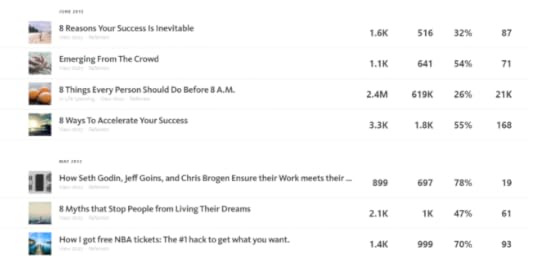
As can be seen in the image, one of my articles in June went viral. Honestly, I wasn’t at all prepared for the traffic my website got when this happened. My website was extremely crappy (like, the worst). More importantly, my website OPT-IN (where you collect email addresses) was not center stage, but small and on the right hand column.
While my viral article was getting the initial wave of traffic (approximately 200,000 clicks per day on Medium), I only received 40 subscribers to my blog. Surely I should be getting thousands of subscribers with this kind of traffic?
It dawned on me that I should be inviting readers to subscribe to my blog directly. Indeed, very few people would take the time to click on my Medium profile or look up my website on their own volition. So I edited the article in Medium and added the following at the end:
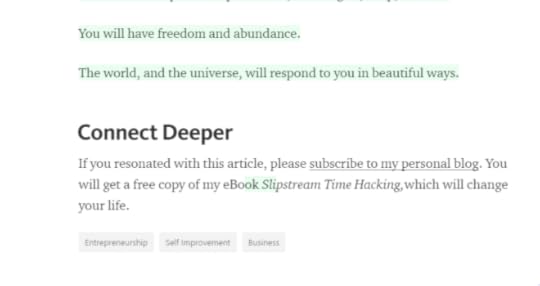
After adding this simple “call to action” (i.e., Connect Deeper), I jumped to 3,500 subscribers in just a few days. Unfortunately for me, this edit was done after most of the traffic had come and gone. So, I missed a huge opportunity, but learned an important lesson.
And that’s where my subscriber-base would sit for the next four months. The day my article went viral, I was contacted by Business Insider, Huffington Post, and the Observer, all asking if they could republish the article. My goal of two weeks prior was abruptly achieved.
I was given my own Huffington Post blog and the Observer said they’d like to pay me to write exclusively for them. I didn’t know what I was doing, and it sounded awesome, so I agreed. For the next four months (from the end of June to the end of October), I published almost all of my work exclusively at the Observer.
Unfortunately, I wasn’t getting very much traffic at the Observer, and my number of subscribers didn’t budge. Please note, I wasn’t putting the “call to action” at the end of my articles at the Observer.
In late October, I transitioned back to having Medium as my main platform for driving traffic to my website and building my reader-base. I immediately started to see a substantial growth in readership.
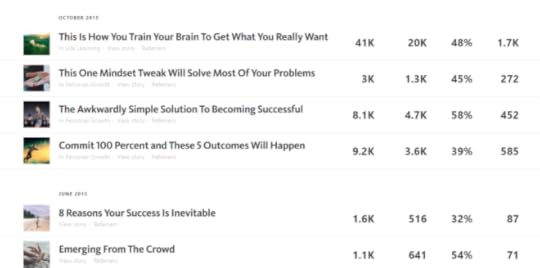
Since returning to Medium in late October, I have increased from 3,500 to 20,000 email subscribers. And in December, I revamped my website, making it far more professional.
Progressively, my followers on Medium increased and I got momentum. Although virility seems like a fluky thing—from my experience, you can come to control and predict what will do well. Here are my Medium stats from December:
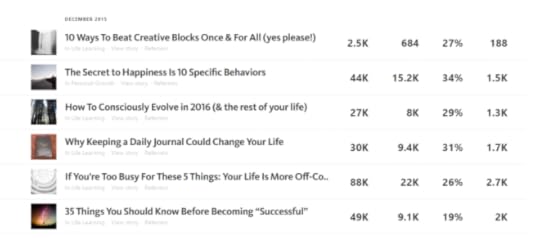
And January 19, 2016:
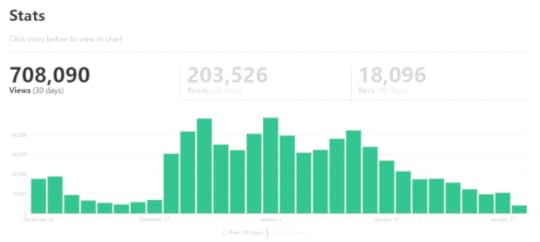
As you can see, there are spikes and drops. However, on Medium, when you have one article that’s getting a lot of traffic, it’s good to publish others. The traffic from one ripples into the traffic of other freshly published articles—they can assist one another.
Furthermore, the traffic from my newly published articles also brought attention back to my article published in June, which rippled back into the newer articles—generating more traffic and more subscribers. For example, the image below shows three of my articles hitting the Top 5 Trending on Medium, two published in January, one from the previous June.
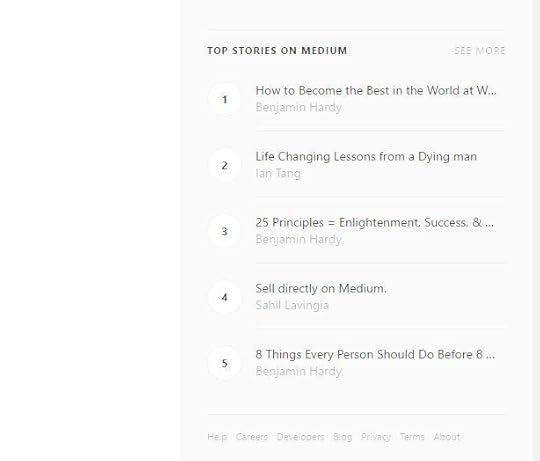
In truth, most of my subscribers have come in the months of December and January. In the past two months, I’ve increased by 13,000 subscribers.
The image below shows my current subscriber base as found in my Infusionsoft management account. Note that 33% were from the last 30 days.
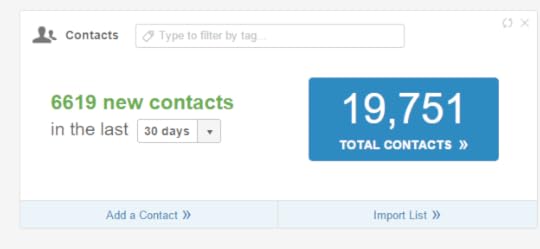
From here on out, I’ll dig into my writing process and some of my strategies for writing valuable material.
Strategy #1: I’m Just Trying To Have As Much Fun As I Can
Our culture has become obsessed with working hard and being busy while simultaneously trivializing the importance of play. Indeed, “The only kind [of play] we honor is competitive play,” says Bowen F. White, MD, a medical doctor and author of Why Normal Isn’t Healthy.
Despite the increasing disinterest in play among American adults, Stuart Brown, founder of the National Institute for Play, has studied the “Play Histories” of over six thousand people and concludes playing can radically improve everything — from personal well-being, to relationships, to learning, and to an organization’s potential to innovate. As Greg McKeown explains, “Very successful people see play as essential for creativity.”
In his TED talk, Brown said, “Play leads to brain plasticity, adaptability, and creativity… Nothing fires up the brain like play.” There is a burgeoning body of literature highlighting the extensive cognitive and social benefits of play, including:
Cognitive
Enhanced memory and focus
Improved language learning skills
Creative problem solving
Improved mathematics skills
Increased ability to self-regulate, an essential component of motivation and goal achievement
Social
Cooperation
Team work
Conflict resolutionLeadership skill development
Control of impulses and aggressive behavior
My approach to writing is to have as much fun as possible. That’s what guides my writing process and my writing progress. For me, it’s like snowboarding—if I’m too serious about it, I’ve missed the point. So I’m just trying new tricks on my snowboard and pushing my creative boundaries because it’s fun. When it stops being fun, I take a step back and question my motivations.
Strategy #2: Experiment
Tim Ferriss doesn’t do what he thinks will make him happy. He does what excites him. Although his overarching vision remains consistent, Ferriss doesn’t have long-term plans.
Instead, he does short-term (e.g., a few months) “experiments,” which he puts all of his energy into. He has no clue what doors may open as a result of these experiments, so why make long-term plans? He’d rather respond to the brilliant and best opportunities that arise, taking him in now unforeseen directions.
I’ve recently adopted Ferriss’ concept of doing short-term experiments. This has changed my approach to work. For example, a few months ago I stumbled upon a personal development article that had over 1,000,000 social shares. I decided to perform an experiment to attempt creating an article that would also get 1,000,000 shares. The result was this article.
Although the article hasn’t been shared a million times yet, the results were profound and unexpected. It drew the attention of an editor at TIME who asked if they could syndicate it at the end of February. Additionally, the article attracted several thousand new readers (including some of my favorite authors & researchers) and subscribers to my blog. Lastly, it connected me with a better web-developer and new coaching clients. All from one short experiment that took a week to perform.
Experiments are a fun way to pursue goals because they allow you to get innovative and bold. Experiments are short-term — and thus relatively low risk. They are your “moon shots.” Why play small? What’s the worst that could happen, you waste a few weeks or months and learn a lot while doing it?
Trying to get several articles into the “Top Stories On Medium” simultaneously was another experiment I tried in December. Even this very article, the one you’re currently reading, is an experiment. Who knows what the results will be?
Strategy #3: Frame My Goals As Quests
I believe most people fail at achieving their goals and resolutions because they perceive their goals to be drudgery. Instead of traditional goal-setting—which is too serious and lacks the whimsy of an epic adventure—I’ve framed my goals as a bucket list. Each item on my bucket list bucket list becomes an epic quest to achieve.
According to Chris Guillebeau, in his book, The Happiness of Pursuit, a quest has a defined beginning and an end. It has various stages and levels, like a video game. It can’t be easy. Challenge is the essence of adventure, and thus, the essence of a quest. A quest must be attainable. For example, Guillebeau didn’t set out to visit every planet in the solar system, but to visit every country in the world (which he completed). Lastly, it must be something pulling deeply at you. If you didn’t do this thing, you’d regret it. Hence, the bucket list informs the quests you undertake.
As an example, rather than trying to publish three articles per week, I’m questing to get published on my favorite platforms. Instead of running four times per week, I’m training for an ultramarathon.
This approach to goal-setting—and living in general—is proactively designing your life around your highest ideals, which is the opposite of what most people do. Most people try to squeeze their dreams and highest ideals into the “margins” of their busy lives. As Stephen Covey explained, “If the ladder is not leaning against the right wall, every step we take just gets us to the wrong place faster.” Thus, pursuing your highest ideals as your top priority keeps you honest to yourself, and allows you to not get caught up in other people’s agendas.
It also makes life a lot of fun!
Strategy #4: Create Content That Is So Good It Can’t Be Ignored
Every article is an opportunity. Don’t publish articles just to hit publish. One blog post could change the entire trajectory of your career.
I believe I’ve had success on Medium because my articles are jam-packed. They aren’t fluffy. They’re dense—and often need to be read and re-read several times. People regularly tell me they’ve printed-out one of my articles and stuck it to their fridge so they can read it daily.
When I write an article, I’m not concerned about how long it will be. Instead, I focus on how good I can make it. I want my art to leave people better than it found them, including you.
Strategy #5: Quantity Facilitates Creativity And Sometimes, Even Masterpieces
In the book Originals, Adam Grant explains that “originals” (i.e., people who create innovative work) are not reliable. In other words, not everything they produce is extraordinary. And the same is true for you. In order to produce your magnum opus, you’ll need to create a high volume of work. You have to kiss a lot of frogs to find your prince.
For example, among the 50 greatest pieces of music ever created, six belong to Mozart, five are Beethoven’s, and three Bach’s. But in order to create those, Mozart wrote over 600 songs, Beethoven 650, and Bach over 1,000.
Similarly, Picasso created thousands of pieces of art, and few are considered to be his “great works.” Edison had 1,900 patents, and only a handful we would recognize. Albert Einstein published 248 scientific articles, only a few of which are what got him on the map for his theory of relativity.
I once asked Seth Godin and Jeff Goins how they each produce high quality work. Here were their responses:
Seth Godin via email: “Plant a lot, harvest a few.”
Jeff Goins via Twitter: “I keep shipping. I find that when I stop producing, the quality goes down. A deadline makes me do my best work.”
Quantity is the most likely path to quality. The more you produce, the more ideas you will have—some of which will be innovative and original. And you never know which ones will click. You just keep creating.
“Quantity is the most likely path to quality.”Benjamin HardyTweet thisTweet
So I ask: Are you creating a large volume of work?
Are you inputting or outputting?
If you like building, build more stuff. If you like writing, write more stuff. If you like connecting, connect more. If you like running, run more. Do stuff. Output. Do it more.
You give your ideas value by acting on them. A good idea, not acted upon, only brings pain and fear. Conversely, action brings confidence. Action is fun. Inaction slowly kills you inside.
Don’t wait to be moved by the spirit. Move the spirit yourself through action. There is no inspiration without action. Action is inspiration. That’s how it works.
Faith is action, and thus also power. Faith and fear cannot co-exist in the same person at the same time. Thus, action (i.e., faith) and inaction (i.e., fear) are opposites. Do what you love. Do it more. Output all the time.
Strategy #6: “Listicles” With Style
A comment on one of my articles:
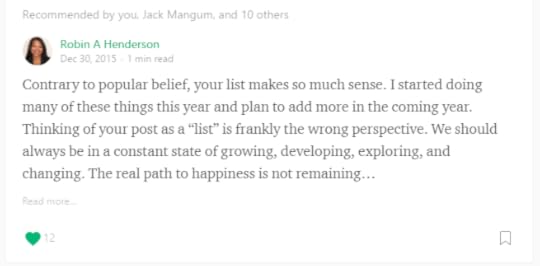
I get messages all the time from people who say stuff like, “Your articles aren’t like the normal listicle type articles. Yours have more substance.”
Not every article should be in list format. But why neglect what works? People love articles written as lists. Consequently, I frame a large portion of my articles as lists. And to be honest, those are the ones that consistently do the best.
The numbers don’t lie.
Within the flexible framework of a list, you have loads of room for creativity. My “list” articles are packed with information and sometimes very long. There are no rules. Just strategies that work or don’t work. Lists—if done well—work.
Strategy #7: Boost Your Opinion With Research And Powerful Quotes
The following image comes from an article I published last week about why I believe we should embrace, rather than avoid, imposter syndrome.
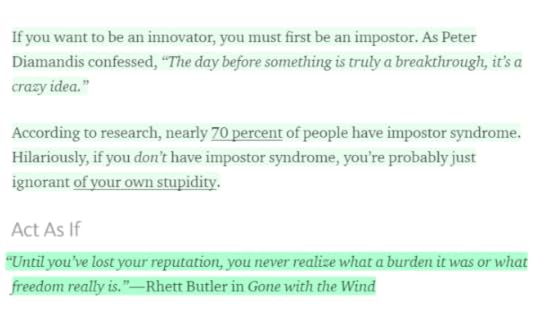
Having great quotes and using research gives you credibility. It also makes your writing more well-rounded and powerful.
Strategy #8: Surprise People
My two most viral articles included elements of surprise. For example, my morning routine article told people they should take cold showers in the morning. Although the rest of the article was good (in my opinion), that one surprising element was the tipping-point.
Similarly, another successful article started with, “Stop Consuming Caffeine.” Although that turned many people off, it also startled and surprised a lot of people.
Add some shock-factor to your writing. Give people something that is either counter-cultural or something they haven’t thought of before but which is relevant and important.
Strategy #9: Syndication
Your biggest problem is obscurity—other people don’t know you and aren’t thinking about you.
—Grant Cardone, The 10X Rule
Personally, I don’t care where my stuff is published. As long as the reader is directed back to my website, anyone who asks if they can republish my work can have it (including you). My only stipulation is that they keep my Connect Deeper section with links back to my website at the end of every article they republish.
This may not be good for SEO purposes. And I may change my strategy in the future. But for now, my goal is to “become omnipresent” as Grant Cardone calls it. I want to increase my odds of getting my writing in front of the right readers and potential collaborators.
Only on rare occasion (like this), will I write an exclusive article.
Conclusion
So there you have it. I did it. I’m doing it. And you can, too.
Connect Deeper
If you resonated with this article, please subscribe to my personal blog. You will get a free copy of my eBook Slipstream Time Hacking, which will change your life.
Have you published anything on Medium? Which of Benjamin’s tactics do you want to try first? Share in the comments.













